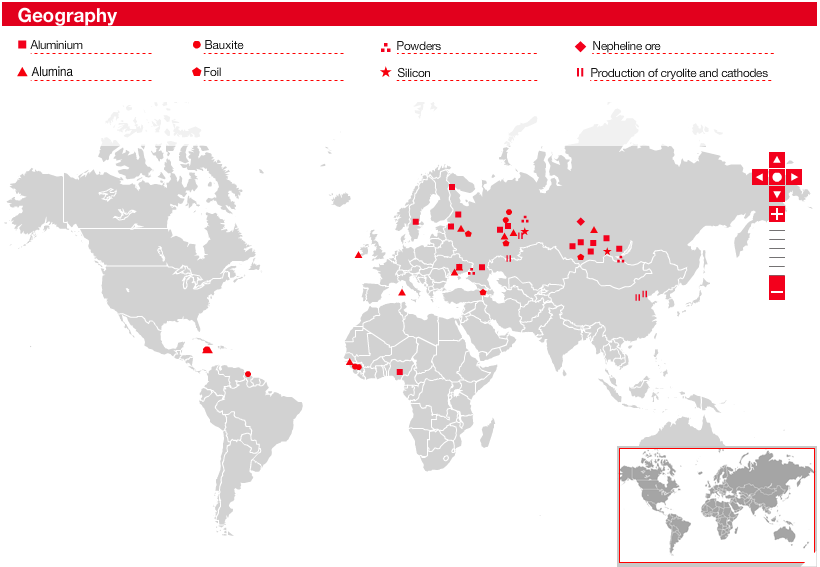
- •International Business Strategy
- •Midterm essay
- •Norilsk Nickel
- •Ownership
- •Internationalization
- •Ummc – Ural Mining and Metallurgical Company
- •Ownership
- •Internationalization
- •Russian copper company - Русская медная компания
- •Ownership
- •Internationalization
- •Armz Uranium Holding Co.
- •Ownership
- •Internationalization
- •Kamensk-Uralsky Metallurgical Works j.S.Co. (kumz)
- •Ownership
- •Internationalization
- •United Co. Rusal.
- •Ownership
- •Internationalization
- •Vsmpo-avisma Corporation.
- •Ownership
- •Internationalization
- •Conclusion
- •Norilsk Nickel
- •Russian copper company - Русская медная компания
- •Armz Uranium Holding Co.
- •Kamensk-Uralsky Metallurgical Works j.S.Co. (kumz)
- •United Co. Rusal.
- •Vsmpo-avisma Corporation.
Internationalization
From
a very scratch, Rusal’s ambition was to go global (this point still
remains #1 priority on the company’s strategic objectives list:
“Reinforce the leadership in the global aluminium industry through
raising production efficiency”28).
The very first step on this way was the acquisition of the Friguia
alumina refinery CBK in the Republic of Guinea. This deal is also a
great example of government interest in the company: from one hand,
the contract was successfully signed due to intergovernmental
agreements between Russia and Guinea, from the other – this deal
played very positive role for the Russian economy as a whole29.
After that, the company acquired 20% of the equity of the world’s
second largest refinery from the production capacity standpoint,
namely Queensland Alumina Ltd, Australia. These deals were followed
by a number of acquisitions in various countries: China, Italy,
Nigeria, Armenia, Ukraine, Kazakhstan, Ireland, Jamaica, Guyana and
Sweden.

All the above-mentioned deals clearly followed the internationalization logic of Rusal: to become a global leader, it needed to meet 2 prerequisites: sufficient supply of bauxite and alumina – the components of aluminium. These matters are characterized by scarcity; thus, the main players of the aluminium market have already secured the deposits long ago. To meet the ambitious goal of the company in such a red-sea environment, management of Rusal opted for M&A as the main tool; notably that the company used both mixed brown-and greenfield strategy. Some plants were built from the scratch in proximity of either bauxite mine or the source of energy, while some foreign assets had to be seriously modernized after being acquired.
As for the on-going investment projects of Rusal, they are aimed at “boosting the company’s production capacity to satisfy the soaring demand for aluminium as well as enhancing production efficiency through introducing cutting-edge technologies and diversifying business by creating its own energy generating capacities”30. Rusal invests heavily in the construction of new facilities, which makes the company uniquely positioned to execute greenfield projects: an in-house engineering and construction division along with Rusal’s own smelting technologies helps the company to cut capital costs and reduce lead time. Russian local resources, such as Siberia’s vast energy resources create a solid platform for Rusal’s further growth. Currently Rusal is carrying out two greenfield projects, namely: creation of a large energy and metals complex in Krasnoyarsk region and construction of Taishet smelter in Irkutsk region. Upon completion, the new facilities will add over 1.3 million tones of aluminium to Rusal’s annual production capacity31. Which is also important, is that the new smelters are being constructed in close proximity to the booming Chinese market and, therefore, are well placed to export its production and benefit from the surging demand in aluminium.
Although Rusal was not the first-mover in its very industry, however, it was the first company to conduct such impressive and daring deals and implement such a successful internationalization strategy.
All the above-mentioned factors coupled with continuous governmental support helped Rusal to become the global leader on the aluminium market32.
